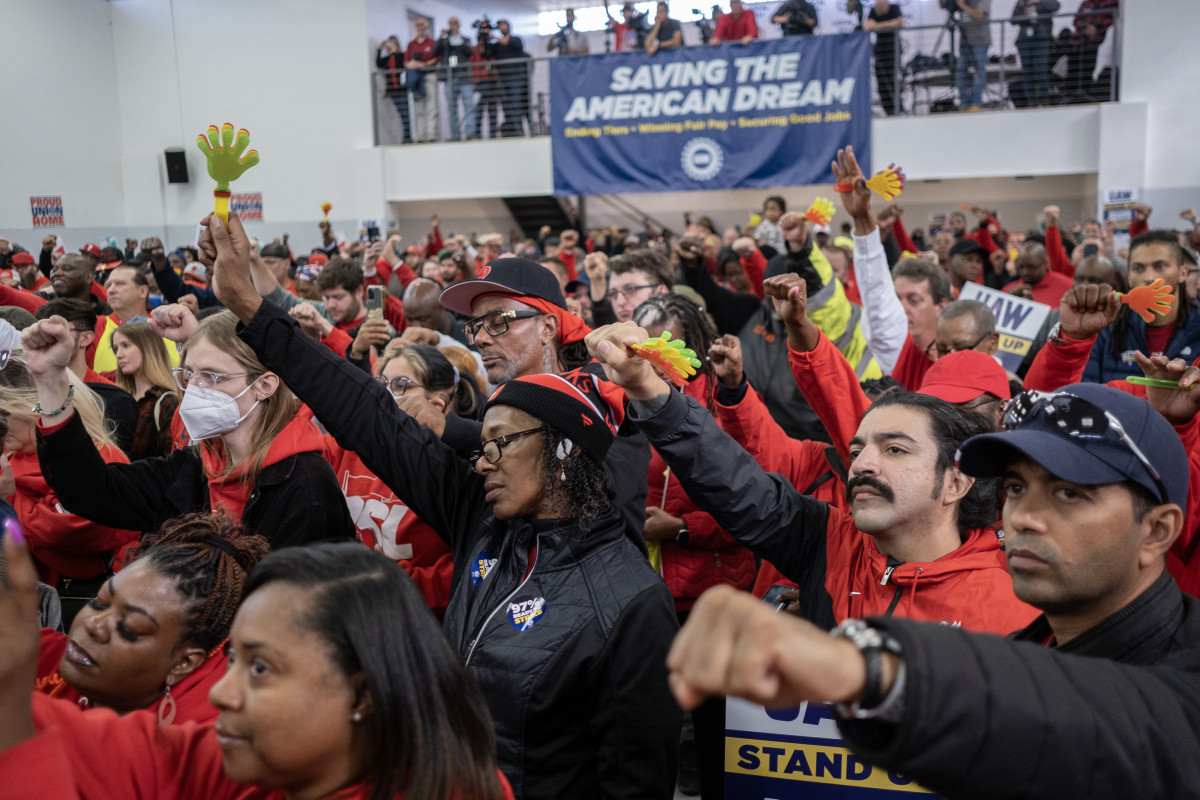
The UAW workers' strike forced America’s largest automakers into a corner. Faced with increasingly more strikes at their highest-profit manufacturing plants, Ford Motor Company, General Motors, and Stellantis STLA, owner of Chrysler, Dodge, and Jeep, agreed to a slate of wage concessions in what turned out to be a record-setting contract.
The striking workers still need to ratify the tentative agreements. However, workers returned to their jobs this week, and most are expected to vote in favor of the plan, which boosts workers’ pay by 25% and gives them a surprisingly big upfront payment.

Striking auto workers had a slate of costly demands
Auto workers were committed to striking as long as necessary to squeeze a record compensation deal and other perks out of Ford, General Motors GM, and Stellantis.
Initially, their wish list was long, including a 40% pay increase, a 32-hour work week, annual cost-of-living increases, more retirement money, additional vacation time, and removing wage tiers.
That long list of demands would’ve been expensive for automakers. Ford said that agreeing to them would put it on a path to bankruptcy. General Motors argued that workers' demands would mean competitors with non-union workforces would leapfrog it, including Tesla TSLA, Honda Motor HMC, and Toyota Motor TM.
Importantly, Detroit’s big three felt that workers' terms would leave them financially hamstrung at a time when the auto industry is knee-deep in a seismic shift toward electric vehicles away from internal combustion engine (ICE) vehicles.
Electric vehicle sales are quickly displacing traditional ICE vehicles, so automakers are investing heavily to ensure they capture their fair share of the market opportunity.
According to Cox Automotive’s Kelley Blue Book, U.S. electric vehicle sales surged by nearly 50% year-over-year in the third quarter, accounting for nearly 8% of all vehicles sold. That growth is far faster than the mid-teens growth for all vehicles sold.
EV growth is only beginning. Wall Street analysts expect EVs will represent 40% of all vehicles sold by 2030.
More Business of EVs:
- A full list of EVs and hybrids that qualify for federal tax credits
- Here’s why EV experts are flaming Joe Biden’s car policy
- The EV industry is facing an unusual new problem
Tesla, a non-union company that pioneered the shift to EVs, dominates the market with a 50% market share. If Ford, General Motors, and Stellantis hope to chip away at Tesla's lead, they'll need to design and launch new and better EV models at similar or lower prices. Last quarter, Ford and GM both lost EV market share to rivals like Hyundai.
Auto workers' ultimatum secures a massive payday
Striking workers didn’t get everything on their wish list, but the pay package offered by Ford, General Motors, and Stellantis is eye-popping.
Ford Motor was the first to ink a tentative agreement with workers, and its deal served as the template for the agreements cut with GM and Stellantis.
Recently, the UAW’s President Shawn Fain explained the details of Ford’s deal to workers ahead of their planned vote.
“For months we’ve said that record profits mean record contracts. And UAW family, our Stand Up Strike has delivered,” said Fain.
Ford Motor’s pay package includes pay raises through 2026, the reinstatement of COLA increases given up during the Great Recession, the elimination of wage tiers put in place during the Great Recession, annual bonuses for retired workers, more profit sharing and retirement money for existing workers, a faster path to the top wage tier, and other perks, including better healthcare, an additional holiday, and more protections for workers if they miss a shift.
Altogether, the UAW says the deal is four times the value of the last contract negotiated in 2019.
Pay will climb 25%, including an immediate 11% bump up in wages. Workers will also pocket a surprising $5,000 bonus for voting for the deal. The top pay hourly pay rate will climb 30% during the contract period to over $40 per hour, including expected inflation adjustments.
Newly hired workers will see a starting pay increase of 68% while existing lower-paid temporary employees could see their pay climb up to 150%. The wage increases over the next four and a half years are larger than all the pay increases given to workers over the last 22 years combined.
Ford also agreed to allow the union to strike over plans to close plants, which wasn’t included in prior contracts. Its 300,000 retirees will collect a $500 annual bonus, costing Ford about $150 million annually. Oh, and if that isn't already enough, workers will receive a $1500 voucher for a new car too.
Overall, Ford estimates the new contract will cost $850 to $900 per car. It doesn’t plan to increase prices to offset the cost, hoping to find the money by cutting other expenses instead. But there’s no guarantee that this agreement won’t cost car buyers more. This year, the average cost of a new car exceeds $48,000, up $10,000 since September 2020, according to Consumer Reports.
While the deal is costly, it would've been even more expensive to let the strike continue.
Ford revealed on Oct. 26 that the strike had already cost it $1.3 billion, and that was without workers striking at its profitable F-150 plant yet. GM said on Oct. 24 that the strike’s cost exceeded $800 million so far, and that was before workers went to the picket line at Arlington Assembly, its biggest money maker.
Ultimately, it was the threat to Ford's F-150 production that got the deal done with it, paving the way to similar agreements with GM and Stellantis.
"We knew we were getting close, but we also knew the companies needed a major push if we were going to make sure we got every penny possible in this agreement. So we took our strike to a new phase and hit the companies with maximum effect," said Fain. "Ford knew what was coming for them on Wednesday if we didn’t get a deal. That was Checkmate."
Sign up to find out what stocks we're buying now (Ford isn't one of them!)







